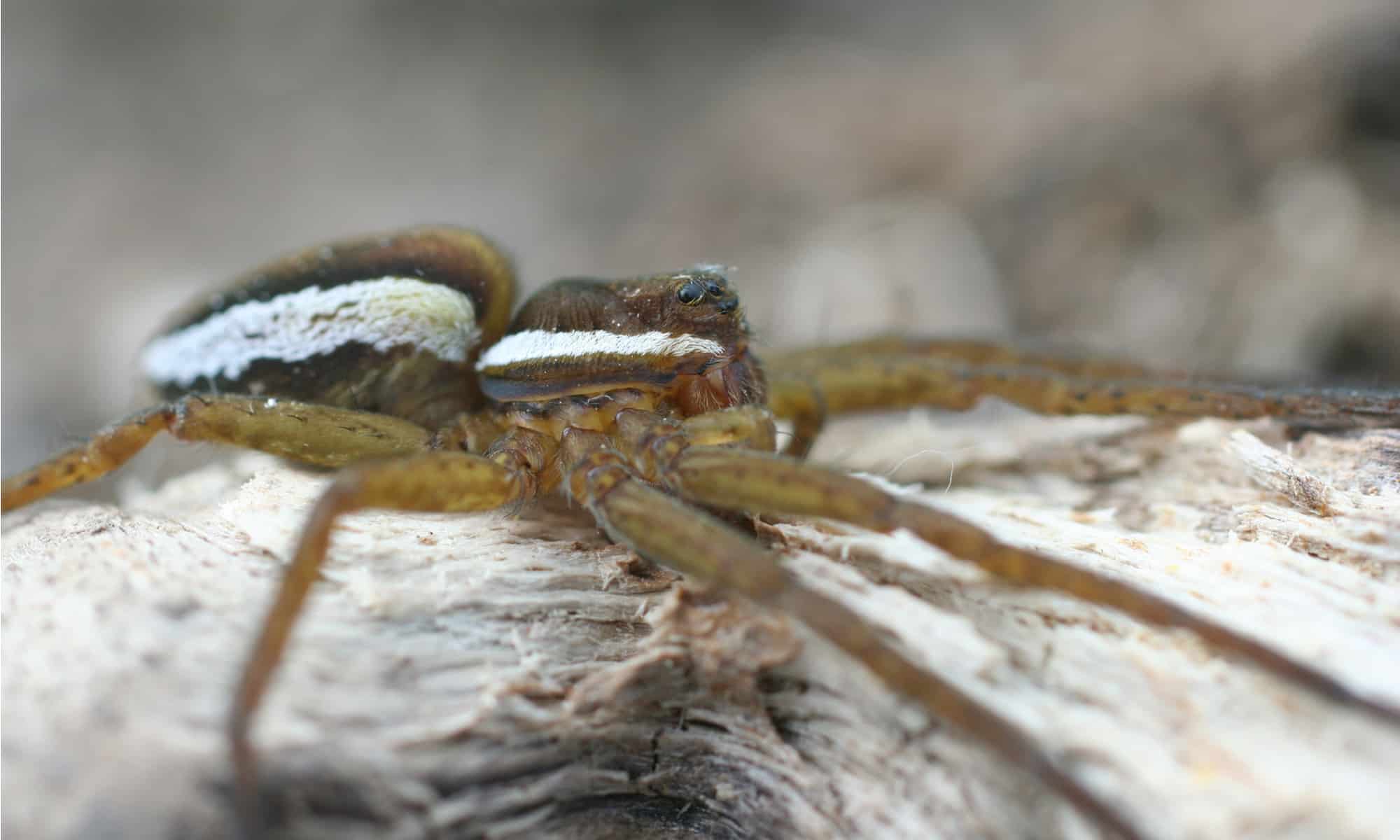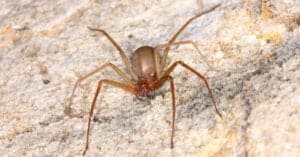Have you ever wondered about the eight-legged wonders lurking in the Great White North? Canada might be known for its vast landscapes and chilly winters, but did you know it’s also home to some pretty big spiders? You won’t find any ginormous spiders in Canada, but there are a few that are impressive in size and appearance. Brace yourselves as we dive into the fascinating world of arachnids that call Canada home! Some of these species might just surprise you with their unique traits and abilities.
1. Striped Fishing Spider
Arguably one of the biggest spiders in Canada has to be the striped fishing spider. The striped fishing spider (Dolomedes scriptus) stands out as one of the largest spider species in Canada. Belonging to the family Pisauridae, this arachnid boasts an impressive size and distinct appearance.
Recognized for its elongated body and remarkable leg span that can extend up to three inches, the striped fishing spider sports a striking coloration. Its cephalothorax and abdomen showcase a unique pattern of dark and light stripes, which aids in its camouflage while resting on vegetation near water bodies. The long legs are well-suited for its semi-aquatic lifestyle, enabling it to move efficiently on both land and water surfaces.
This spider is commonly found across various provinces in Canada, especially in regions with suitable habitats like marshes, ponds, and streams. The striped fishing spider prefers environments near water, where it can hunt for aquatic insects and even small fish. Its ability to walk on water is facilitated by tiny hairs on its legs that trap air, creating a layer of buoyancy.
As a predator, the striped fishing spider relies on its keen eyesight to spot prey on the water’s surface. Once it detects a potential meal, the spider uses its agility and speed to glide across the water and capture its prey with its strong, sharp fangs. Its hunting prowess and size make it a fascinating species for nature enthusiasts to observe in the wild.
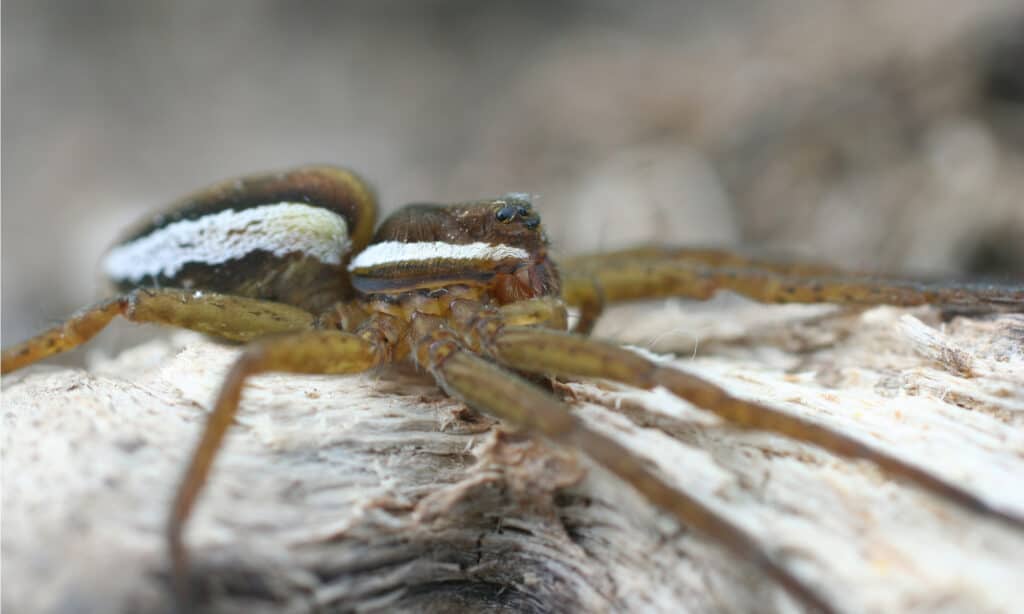
The striped fishing spider is generally considered to be the largest spider species native to Canada.
©Oleg Nikonov/Shutterstock.com
2. Dark Fishing Spider
The dark fishing spider (Dolomedes tenebrosus) ranks among the largest spider species in Canada. Classified within the Pisauridae family, this arachnid boasts an impressive size and distinct appearance.
Characterized by its robust body and notable leg span, which can stretch up to over an inch, the dark fishing spider showcases a dark brown to black hue. Its cephalothorax and abdomen exhibit a sleek and shiny appearance, with a noticeable pattern of pale markings on its abdomen. Its eight long legs are adapted for moving both on land and water surfaces, which is a defining feature of this semi-aquatic species.
This spider is commonly spotted across various provinces in Canada, particularly in areas with suitable habitats such as wetlands, ponds, and slow-moving streams. The dark fishing spider prefers environments near water, where it can effectively hunt aquatic insects and other small prey. Its ability to move gracefully on water is made possible by fine hairs on its legs that trap air, enabling it to stay afloat.
As a skilled predator, the dark fishing spider relies on its excellent eyesight to locate potential prey on the water’s surface. Once it detects movement, the spider uses its agility and rapid movements to navigate the water and seize its prey using its formidable fangs. This hunting prowess, combined with its size, makes it an intriguing species for those interested in studying the diverse wildlife in Canada.
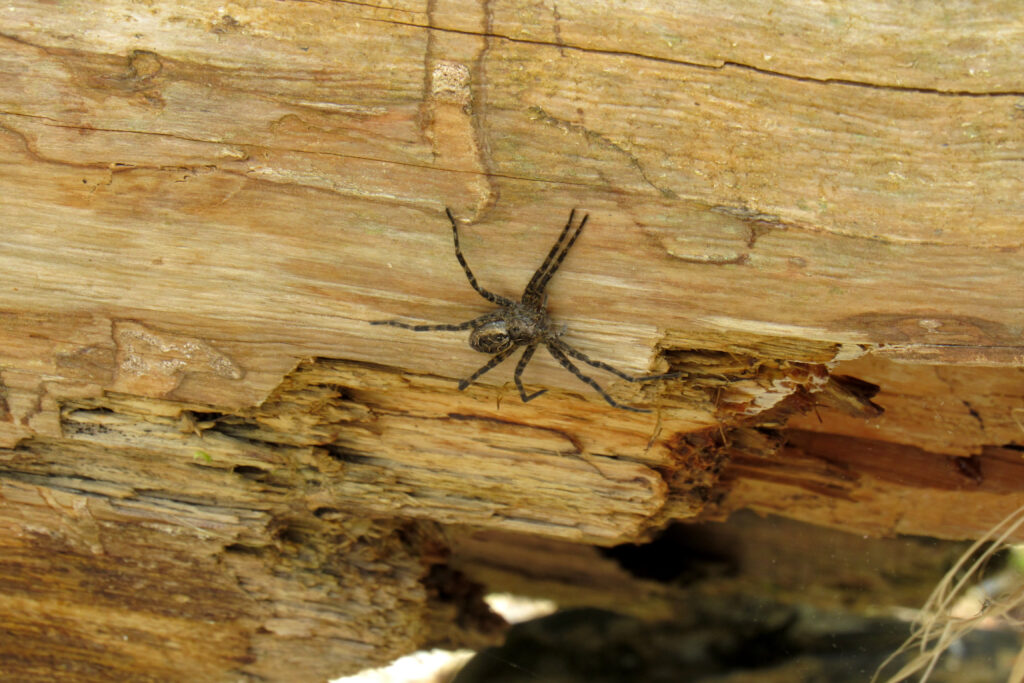
Dark fishing spiders have banded legs and a unique coloration that makes them distinctive from the striped fishing spiders.
©Bailey Davenport/Shutterstock.com
3. Nursery Web Spider
The nursery web spider (Pisaurina mira) holds a prominent spot among Canada’s arachnid population as one of the largest spider species. Belonging to the Pisauridae family, this spider possesses distinct characteristics that make it both captivating and intriguing.
Measuring around three-quarters of an inch in length, the nursery web spider boasts a somewhat sizable physique for a Canadian spider. Typically, its coloration varies in shades of brown and gray, allowing it to blend effectively into its surroundings. Notably, female nursery web spiders are known for their distinctive behavior of carrying their egg sacs beneath their bodies using their jaws, ensuring their protection and care.
Across various regions in Canada, the nursery web spider finds its habitat near sources of water, such as ponds, marshes, and streams. Frequently encountered resting on plants near water, these spiders utilize their silk to create unique shelters that resemble nursery webs. Within these silk shelters, females vigilantly guard their eggs until they hatch, continuing to provide care and protection to their offspring even after hatching.
Unlike traditional web-weaving spiders, nursery web spiders are skilled predators that rely on their active hunting techniques. They pounce on unsuspecting prey, such as insects and other small creatures, immobilizing them with their venom. This approach showcases their agility and adaptability in securing food.
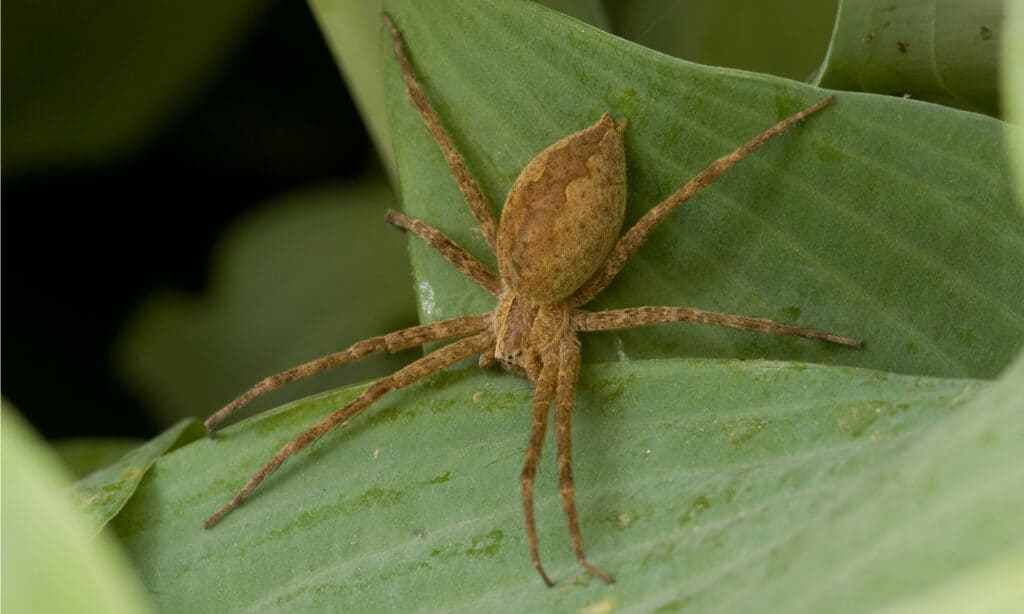
Male nursery web spiders will tie together their female mate’s legs during the mating process to avoid being eaten afterward.
©SDeming/Shutterstock.com
4. Wolf Spider
The wolf spider, which refers to a group of spiders in the Lycosidae family, commands attention as one of the biggest arachnids in Canada. This spider species possesses distinctive characteristics that set it apart, making it both intriguing and noteworthy.
Characterized by a substantial size, wolf spiders typically have an overall length of over one inch. The wolf spider’s coloration varies, often consisting of shades of brown, gray, or even black, allowing them to blend adeptly into their surroundings.
Across various provinces of Canada, wolf spiders are commonly found in diverse habitats, including forests, grasslands, and even urban areas. These versatile spiders are known for their adaptability, and they can be discovered in various nooks and crannies. They often reside on the ground, where they create burrows or shelters beneath leaves, rocks, or debris. These hideouts serve as both protection from predators and as strategic locations for ambushing prey.
As active hunters, wolf spiders do not rely on webs to catch their meals. Instead, they chase and pounce on their prey with speed and precision. Their keen eyesight and sensory hairs on their legs aid in detecting movements and vibrations, allowing them to pinpoint their quarry effectively. They are skilled hunters of insects, playing a role in regulating local insect populations.

Wolf spiders may have a formidable appearance and hunting style, but they are generally harmless to humans.
©Paul Reeves Photography/Shutterstock.com
5. Marbled Orb-Weaver
The marbled orb weaver (Araneus marmoreus) holds a notable place among Canada’s arachnid inhabitants as one of the larger spider species. Classified under the Araneidae family, this spider exhibits distinctive traits that make it stand out in the world of spiders.
The marbled orb weaver typically boasts an overall length of about three-quarters of an inch, though some can get bigger. The marbled orb weaver’s color palette is captivating, featuring vibrant and earthy hues such as orange, yellow, brown, and white. This unique combination of colors creates a marbled pattern on its body, adding to its visual appeal.
This species is distributed across diverse regions of Canada. The marbled orb weaver can be found in habitats like meadows, gardens, and woodlands. These skilled weavers construct intricate orb-shaped webs, composed of a circular frame and a central hub where the spider awaits potential prey. This web-building prowess showcases the spider’s adaptability to various environments and its crucial role in maintaining local insect populations.
As nocturnal predators, marbled orb weavers emerge during the night to actively search for prey or mend their webs. Their diet primarily consists of small insects such as flies, mosquitoes, and moths. Their strategic web placement allows them to maximize their chances of ensnaring unsuspecting insects.

Marbled orb weavers, as well as orb weavers in general, are known for making pretty substantial webs to hunt.
©JT Fisherman/Shutterstock.com
6. Woodlouse Spider
The woodlouse spider (Dysdera crocata) is another one of the larger spider species within Canada. Classified under the family Dysderidae, this spider possesses distinct attributes that distinguish it within the arachnid world.
Recognized for its size, the woodlouse spider generally reaches about three-quarters of an inch in length, especially the females. The woodlouse spider’s coloration is intriguing, characterized by shades of reddish-brown or even dark purple, which sets it apart from other spiders.
The woodlouse spider can be found across Canada in various regions, often taking up residence in damp or humid environments like gardens, cellars, and woodpiles. These spiders exhibit unique behaviors in their hunting methods. Unlike many spiders that construct webs to catch prey, the woodlouse spider is a skilled predator of woodlice, sowbugs, and pillbugs. It uses its powerful fangs to inject venom that immobilizes its prey. This specialized hunting behavior demonstrates the spider’s adaptation to its preferred diet and habitat.
Despite its fearsome appearance and hunting techniques, the woodlouse spider is not harmful to humans. It lacks the potent venom needed to pose a significant threat. This spider’s ecological role in controlling woodlice populations contributes to maintaining a balanced ecosystem.

The woodlouse spider gets its name from the fact that it targets woodlice as its main source of food.
©Macronatura.es/Shutterstock.com
7. Ground Spiders
The ground spider, a member of the Gnaphosidae family, stands out as one of the larger spider species found in Canada. With distinct attributes and characteristics, this spider captures attention within the world of arachnids.
Noted for its size, the ground spider typically exhibits a body length ranging from half to three-quarters of an inch. The ground spider’s coloration varies, often encompassing shades of brown, gray, or even black. This allows it to blend adeptly into its surroundings.
The ground spider’s habitat spans diverse regions across Canada, often residing in leaf litter, under stones, and within crevices. Their adaptability to various environments and hunting styles makes them a versatile and intriguing arachnid species. As adept predators, ground spiders are skilled hunters, relying on their keen senses to detect vibrations and movements. They actively chase and capture their prey, which mainly includes insects like ants, beetles, and other small creatures. This active hunting technique distinguishes them from spiders that rely on webs for catching prey.
Despite their larger size and formidable appearance, ground spiders are not harmful to humans. They lack the potent venom associated with more dangerous species. Instead, these spiders play an important ecological role by controlling insect populations and helping to maintain a balanced ecosystem.
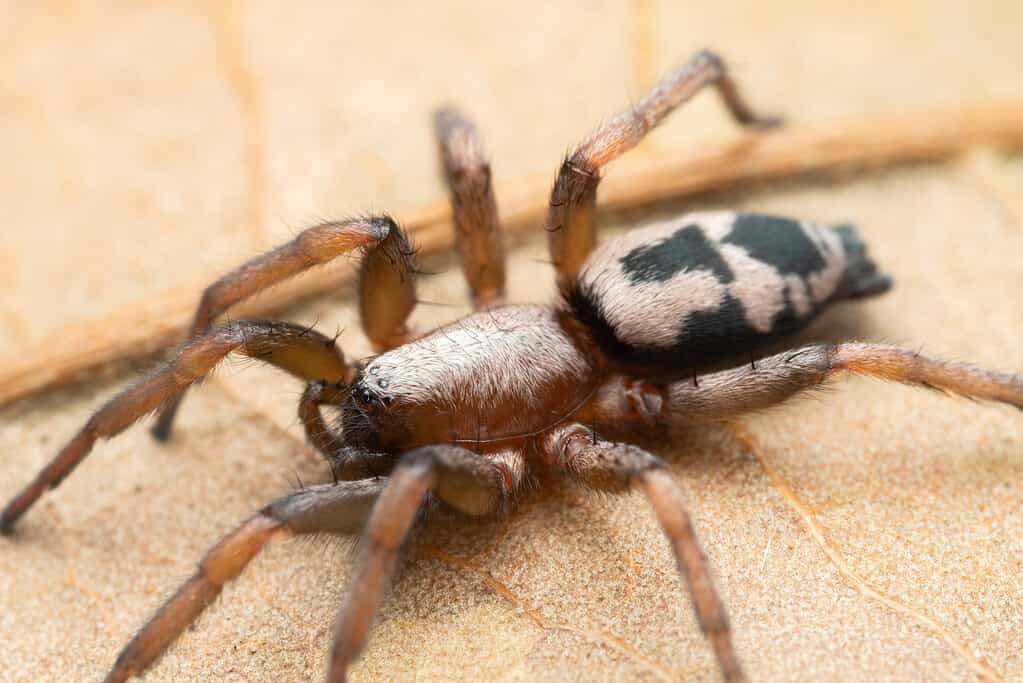
is one of many ground spider species in Canada.
©Marshal Hedin from San Diego, USA, CC BY-SA 2.0 via Wikimedia Commons – Original / License
8. Hacklemesh Weavers
Hacklemesh weavers, belonging to the family Amaurobiidae, rank among the larger spider species inhabiting Canada. These spiders possess notable characteristics that distinguish them within the arachnid world.
The size of hacklemesh weavers is noteworthy in a country with mostly very small spiders, with an overall length of around half an inch long. Hacklemesh weavers often showcase colors of brown, gray, or even black, allowing them to blend effectively into their surroundings.
Found across diverse regions in Canada, hacklemesh weavers tend to inhabit habitats such as forests, grasslands, and even urban areas. These versatile spiders construct irregular, tube-like webs that they strategically position in vegetation, under rocks, or within crevices. These webs serve as traps for unsuspecting prey like insects and other small creatures, highlighting their adaptive hunting techniques.
Hacklemesh weavers possess specialized leg structures covered with stiff hairs, giving them a unique appearance. They use these hairs to detect vibrations, aiding in locating potential prey or sensing predators. Additionally, these spiders are known for their nocturnal habits, emerging during the night to hunt and maintain their webs.
While hacklemesh weavers may appear formidable due to their size and distinctive features, they pose no harm to humans. Their venom is not potent enough to cause significant harm, and they typically prefer to avoid confrontation. Instead, they play an essential role in regulating insect populations and contributing to the balance of local ecosystems.

Hacklemesh weavers may be the smallest spider on this list, but it’s still worth noting that it is larger than most spiders in Canada.
©Eric Isselee/Shutterstock.com
Is Canada Known for Its Big Spiders?
Canada is not widely known for having a significant number of large spider species compared to some other parts of the world. There are indeed larger spider species in Canada. However, they are not as numerous or prominent as in regions with warmer climates. The country’s colder climate and diverse habitats influence the types and sizes of spiders found there.
Some larger spider species do exist in Canada, such as the striped fishing spider, marbled orb weaver, and wolf spider that we mentioned in this guide. These spiders showcase varying sizes and distinctive appearances, contributing to the arachnid diversity in the country. However, Canada’s spider population primarily comprises smaller species adapted to its climate.
The focus in Canada tends to be more on diverse wildlife and ecosystems rather than specifically on large spiders. The country’s ecosystems offer a habitat for various animals, including insects and arachnids, each playing a role in maintaining the balance of the environment.
So, to put it simply, while Canada does have some larger spider species, it is not necessarily known for them. The country’s climate and habitats shape its spider diversity, with smaller species being more prevalent. Canada’s rich natural landscapes offer a home to a wide range of wildlife, contributing to its reputation as a haven for diverse ecosystems rather than for its large spiders.
Summary of the Biggest Spiders Crawling Around Canada
| # | Spider | Scientific Name |
|---|---|---|
| 1 | Striped Fishing Spider | Dolomedes scriptus |
| 2 | Dark Fishing Spider | Dolomedes tenebrosus |
| 3 | Nursery Web Spider | Pisaurina mira |
| 4 | Wolf Spider | Lycosidae family |
| 5 | Marbled Orb-Weaver | Araneus marmoreus |
| 6 | Woodlouse Spider | Dysdera crocata |
| 7 | Ground Spiders | Gnaphosidae family |
| 8 | Hacklemesh Weavers | Amaurobiidae family |
Thank you for reading! Have some feedback for us? Contact the AZ Animals editorial team.

